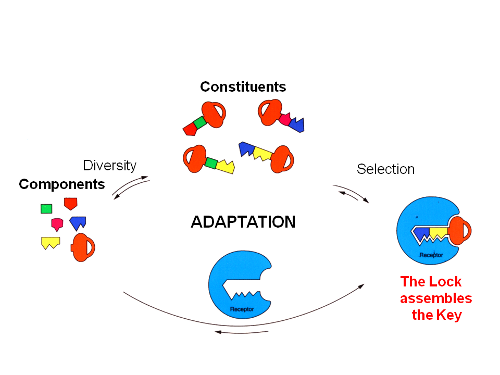Molecular chemistry has developed a wide range of very powerful procedures for building ever more complicated molecules from atoms linked by covalent bonds. Beyond molecular chemistry lies supramolecular chemistry which aims at constructing highly complex chemical systems from components held together by non-covalent intermolecular forces.
Supramolecular chemistry has relied on the development of preorganized molecular receptors for effecting molecular recognition, catalysis and transport processes, on the basis of the molecular information stored in the covalent framework of the components. A step beyond consists in the design of systems undergoing self-organization, i.e., systems capable of spontaneously generating well-defined functional supramolecular architectures by self-assembly from their components.
Supramolecular chemistry is intrinsically a dynamic chemistry in view of the lability of the interactions connecting the molecular components of a supramolecular entity and the resulting ability of supramolecular species to exchange their constituents. The same holds for molecular chemistry when the molecular entity contains covalent bonds that may form and break reversibility, so as to allow a continuous change in constitution by reorganization and exchange of building blocks. These features define a Constitutional Dynamic Chemistry (CDC) on both the molecular and supramolecular levels.
CDC brings about a paradigm shift with respect to constitutionally static chemistry. The latter relies on design for the generation of a target entity, whereas CDC takes advantage of constitutional dynamics to allow for variation and selection. The introduction of selection into chemistry represents a fundamental change in outlook. It implies operating on dynamic constitutional diversity to achieve adaptation, in response to either internal or external factors.
The combination of the features, - dynamics and structural diversity, -constitution and selection, points towards the emergence of adaptive and evolutive chemistry.
References:
Lehn, J.-M., Supramolecular Chemistry: Concepts and Perspectives, VCH Weinheim, 1995.
Lehn, J.-M., Dynamic combinatorial chemistry and virtual combinatorial libraries, Chem. Eur. J., 1999, 5, 2455.
Lehn, J.-M., Programmed chemical systems : Multiple subprograms and multiple processing/expression of molecular information, Chem. Eur. J., 2000, 6, 2097.
Lehn, J.-M., Toward complex matter: Supramolecular chemistry and self-organization, Proc. Natl. Acad. Sci. USA, 2002, 99, 4763.
Lehn, J.-M., Toward self-organization and complex matter, Science, 2002, 295, 2400.
Lehn, J.-M., Dynamers : Dynamic molecular and supramolecular polymers,
Prog. Polym. Sci., 2005, 30, 814.
Lehn, J.-M., From supramolecular chemistry towards constitutional dynamic chemistry and adaptive chemistry, Chem. Soc. Rev., 2007, 36, 151.
